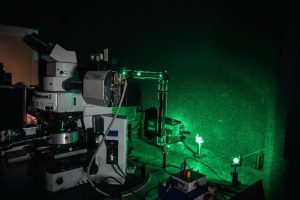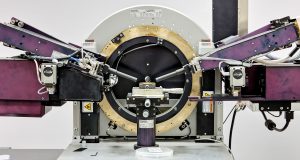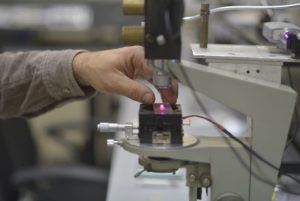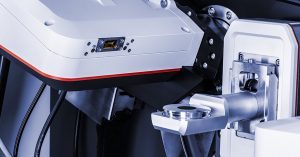Title: "Exploring spectroscopic fingerprints of defects and dopants in two dimensional magnetic insulators"
Program: Bilateral collaboration
Project duration: 2024. - 2026.
Project number: 337-00-140/2023-05/12
PI: Andrijana Šolajić
Abstract:
The air-stable two-dimensional magnetic insulators with long-range magnetic ordering at room temperature are a “game-changer” in the field of 2D materials and 2D magnetism. These could be used in the next generation magnetoresistive tunnelling junctions, lifting the constrain of using hard/soft magnetic electrode materials in magnetoresistive random-access memories. The project is focused on ion implanted talc, a layered magnetic 2D insulator. We intend to combine first principle calculations with state of the art ion beam implantation of magnetic ions into phyllosilicate single crystals. Our combined theoretical and experimental study will focus on pinpointing the spectroscopic fingerprints of specific defects in 2D phyllosilicates. Using the first principle calculations, we will model various types of defects in phyllosilicates, and predict their characteristic vibrational modes. This will be an essential information to the Raman spectroscopy experiments, in order to fully understand and determine specific types of defects in 2D magnetic phyllosilicates.
Title: "Nonthermal Phase transitions in 2D Gallium Sulphide for Applications in Next-Generation Devices"
Program: Programme for Funding Multilateral Scientific and Technological Cooperation Projects in the Danube Region
Project duration: 01.07.2023. - 30.06.2025.
Project number: 337-00-140/2023-05/12
PI: Dr Vladimir Damljanović
Abstract: The main task of the project is theoretical-numerical-experimental study and induction of a non-thermal transition between the 2H and 1T phases of two-dimensional gallium sulfide consisting of a single layer with four planes. The project includes the study of the given transition using Landau's theory of second-order phase transitions (using symmetry) and its extension to the first-order transition, then numerical simulation of the transition using density functional theory and finally the fabrication of samples and induction of the transition by stretching in the laboratory.
Title: "Magnetism Modulation of Self-Assembled Graphene Films for Wastewater Treatment"
Program: Bilateral project beetween Serbia and Austria
Project number: 337-00-577/2021-09/50
Project duration: 2022. - 2024.
PI: Dr Tijana Tomašević-Ilić
Title: "Nanoscale electrical properties of van der Waals heterostructures composed of two-dimensional materials and organic semiconductors"
Program: Bilateral project beetween Serbia and Austria
Project number: 451-03-02141/2017-09/32
Project duration: 2018. - 2019.
PI: Dr Borislav Vasić
Title: "Development of robust and efficient LOS-MIMO antenna arrays, adaptive beamforming algorithms, and high performance signal processing for 5G multigigabit broadband wireless communications" (Acronym: 5G-MIMO-Array)
Program: DAAD Project of Bilateral Cooperation with Germany
Project duration: 01.01.2018. - 31.12.2019.
Principal investigator on the side of Germany: Prof. Dr Eckhard GRASS, IHP – Leibniz-Institut für innovative Mikroelektronik, Im Technologiepark 25, Frankfurt (Oder), Germany and Humboldt-Universität zu Berlin, Unter den Linden 6, Berlin, Germany
Principal investigator on the side of Serbia: Dr Andjelija ILIĆ,
Institute of Physics Belgrade (IPB), Pregrevica 118, 11080 Belgrade, Serbia
Participants: Dr Andjelija ILIĆ (IPB), Dr Slobodan SAVIĆ (IPB-ETF), Prof. Dr Milan M. ILIĆ (IPB-ETF),
Nebojša VOJNOVIĆ (IPB-ETF), Prof. Dr Eckhard GRASS (IHP), Dr Zoran STAMENKOVIĆ (IHP), Nebojša MALETIĆ (IHP)
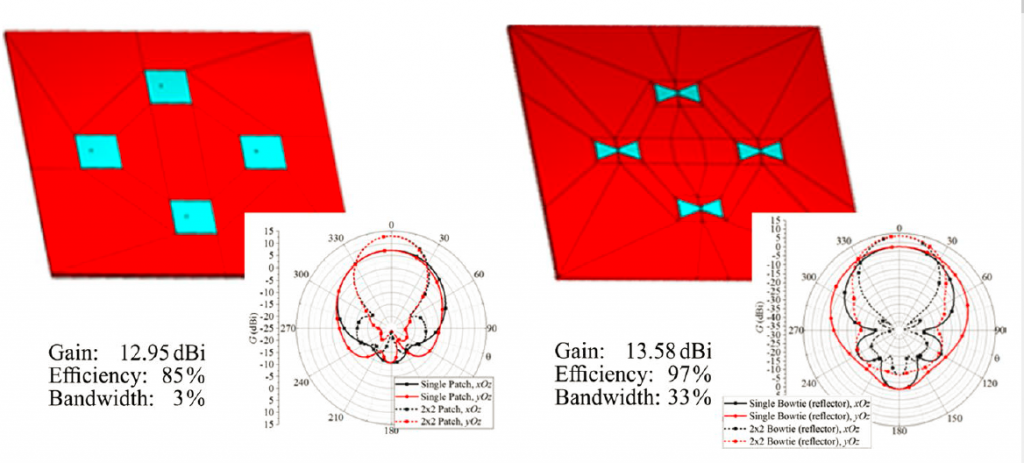
(Selected publication: https://doi.org/10.1007/s11277-019-07007-4 )
Title: "Synthesis and characterization of ternary Van der Waals MoxWx-1S2 nanotubes for advanced field emission application"
Program: Bilateral project between Serbia and Slovenia
Project duration: 2023. - 2025.
PI: Bojana Višić
Inorganic layered materials, where atomic or molecular layers are formed by atoms held together in-plane by covalent or ionic bonds, and out-of-plane via weak van der Waals interactions, are abundant in nature. While readily found in a three-dimensional (3D) structure, these inorganic materials regained popularity when, after isolation of graphene in 2004, it was shown that they can be exfoliated as well in a 2D form (Novoselov et al., PNAS 102 (2005)). Furthermore, these materials have been synthesized in a nanotube (NT) or fullerene-like morphologies back in 1992, making them available in 3D, 2D and quasi-1D form (Tenne et al., Nature 360, 6403 (1992)). This family of materials is extremely versatile, as they can range from being paramagnetic, diamagnetic, ferro- or antiferromagnetic depending on the phase. Furthermore, their bandgaps can range from IR to UV throughout the visible range, making them metallic to semiconducting or insulating in nature. These properties make them interesting candidates for assembling into stacked heterostructures or alloys, combining the properties of individual material into a hybrid structure.
In this project, we will attempt a one-pot synthesis of ternary transitional metal dichalcogenides, with main focus on MoxW1-xS2 and NbxTa1-xS2. The chemical transport reaction inside quartz ampules has been used at Institute Jozef Stefan (IJS) for pioneering syntheses of various inorganic nanotubes and nanowires. This approach will be modified in order to obtain hybrid materials in form of nanotubes or ribbons. The motivation behind this synthesis route is the simplicity behind the one-pot growth and the resulting highly crystalline structures. Here, by growing the material inside a closed quartz ampule at nearly equilibrium conditions and with very slow growth rate, one can minimize the density of inbuilt structural defects and simultaneously obtain different morphologies of the material: flakes, nanotubes, nanoribbons, and scrolls. MoxW1-xS2 hybrid material is chosen as the starting material since the properties of both constituents (MoS2 and WS2) are well known, with the rising interest in their heterostructures in recent years.
Temperature-dependent Raman spectroscopy will be used to study the changes in phonon behaviour in such hybrid materials. Using density functional theory (DFT) calculations, the lattice dynamic will be studied. Their electrical properties will be determined and a single-nanotube transistor will be made. With field-effect transistors already prepared from both MoS2 and WS2 (Levi et al, Nano Lett 13 (2013); Fathipour, APL 106 (2015)), it can be expected that their hybrid has a potential as a component for optoelectronic devices. In the case of NbxTa1-xS2, since both NbS2 and TaS2 are materials that sustain charge density waves (CDW), their hybrid can be interesting to study with respect to modification of CDWs with composition change.
Title: "Millimetre wave wireless systems featuring antennas with orbital angular momentum (OAM) multiplexing" (Acronym: OAM-MUX)
Program: Project of Bilateral Cooperation with Germany
Project duration: 01.01.2023. - 31.12.2024.
Principal investigator on the side of Germany: Prof. Dr Eckhard GRASS, IHP – Leibniz-Institut für innovative Mikroelektronik, Im Technologiepark 25, Frankfurt (Oder), Germany and Humboldt-Universität zu Berlin, Unter den Linden 6, Berlin, Germany
Principal investigator on the side of Serbia: Prof. Dr Milan M. ILIĆ, School of Electrical Engineering (ETF), University of Belgrade, Belgrade, Serbia
Participants: Prof. Dr Milan M. ILIĆ (ETF), Dr Andjelija ILIĆ (IPB), Dr Slobodan SAVIĆ (ETF), Jelena TRAJKOVIĆ (IPB), Darko NINKOVIĆ (ETF), Prof. Dr Eckhard GRASS (IHP), Nebojša MALETIĆ (IHP), Prof. Dr Miloš KRSTIĆ (IHP)
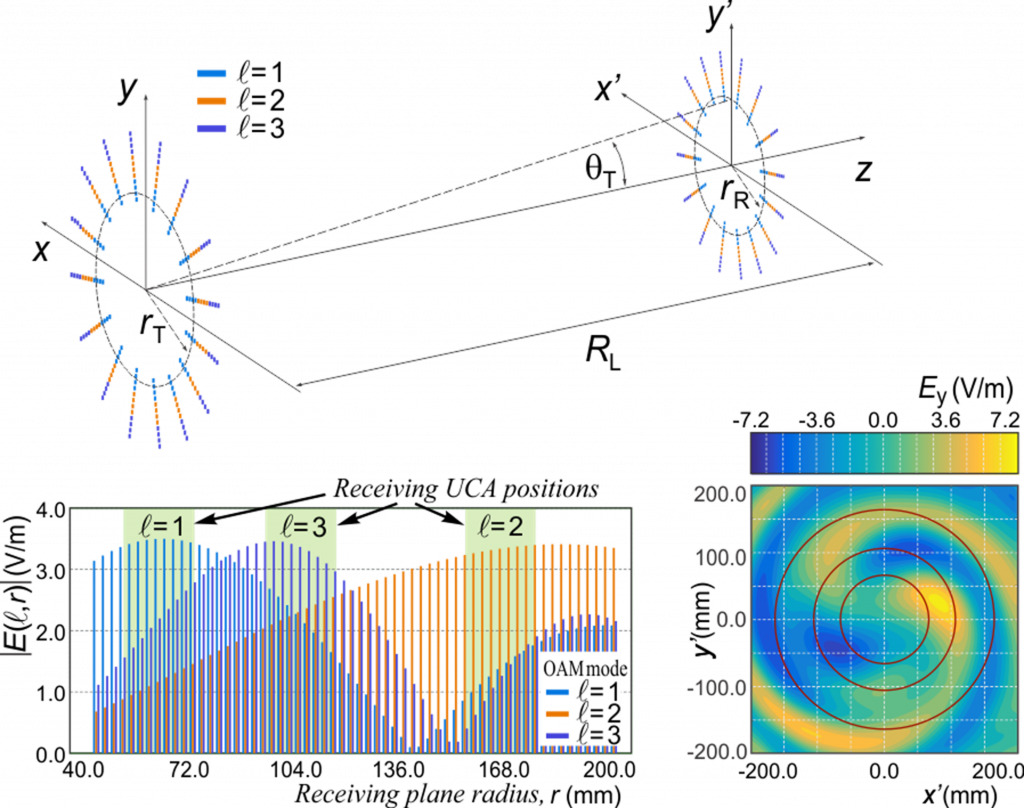
Selected publication: https://doi.org/10.1002/dac.5623
Title: "Multiferroic Perovskite-Based Nanostructures for EMI Shielding and Photovoltaic Applications"
Program: Bilateral project between Serbia and India
Project duration: 2022. - 2024.
PI: Dejan Djokić
This project focuses on addressing the adverse effects of Electromagnetic Interference (EMI) emitted from Photovoltaic (PV) devices in residential solar panels. Traditional materials used in PV systems are limited in their ability to shield against EMI while meeting efficient PV requirements. This project focuses on utilizing nanoscaled multiferroic BiFeO3 as a prospective candidate due to its unique properties, such as a narrow and tunable bandgap and high remnant polarization. The study intends to synthesize nanoscaled BiFeO3 and related heterostructured polymer composites doped with various metals to optimize their bandgap and conduction properties. Structural, optical, PV, and EMI-shielding properties of these materials will be investigated using non-invasive spectroscopic techniques such as Raman and Infrared spectroscopy, along with current-voltage and shielding effectiveness measurements. Collaboration between Indian and Serbian research groups will facilitate the synthesis and characterization of BiFeO3 nanostructures and composites. Additionally, the project aims to train young scientists in solar cell technology research through educational activities, ultimately enhancing both countries' abilities to contribute to future renewable energy projects and EM radiation protection priorities.
Title: "Modelling and measuring phase transitions and optical properties for perovskites"
Program: Bilateral project beetween Serbia and Austria
Project number: 451-03-02141/2017-09/31
Project duration: 2018. - 2019.
PI: Dr Jelena Pešić

